I glance across the room and catch a glimpse of my nose. A simple, flesh-colored, nose-shaped piece of plastic, leaning up against my old “Firebirds 1969” baseball trophy. Only the head of the little gold-plated ballplayer is visible above the nose, so it looks like my nose has a little golden head of its own.
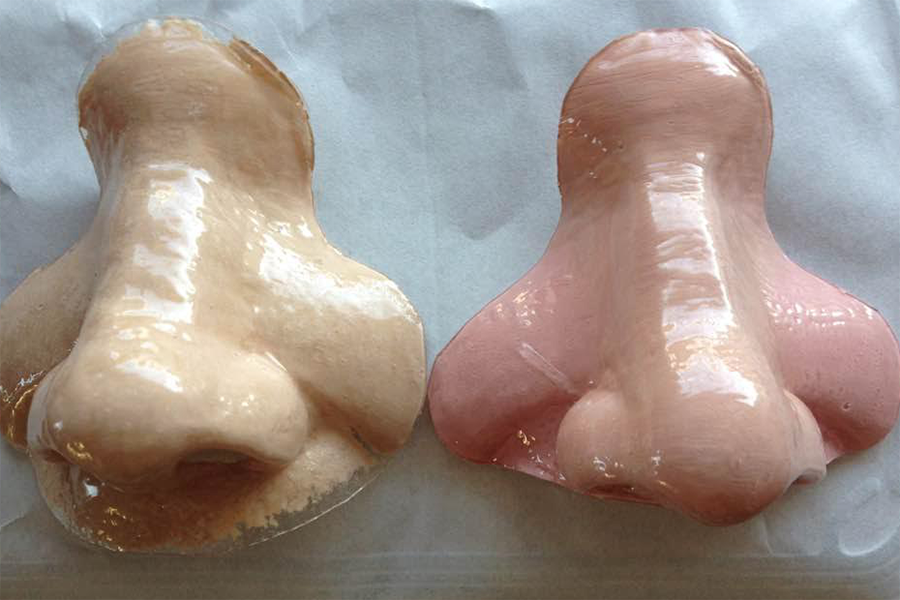
I stare at that overpriced schnoz (it cost me about $80, but it can’t be made of more than a nickel’s worth of plastic), and I think, That’s a long road. From nine-year old with a trophy to 58-year-old with a large hole in the middle of my face. If Coach Aronson had told me in 1969 that in 49 years I’d have a nose-shaped crater in my skull, I certainly wouldn’t have believed him. Because nobody gets their nose cut off.
Except, apparently, me.
My name is Steve Bean Levy. I was a working actor (IMDb “Steve Bean”), a writer of humor, a teacher of improvisation and a maker of funny faces. In November of 2016, though, all of that went out the window. I began to experience chronic nosebleeds. Before long, I didn’t own a single T-shirt or pillowcase that wasn’t blood-stained. The nosebleeds were accompanied by severe congestion; by the end of each day, my sinuses would plug up completely, leaving me unable to breathe through my nose at all.
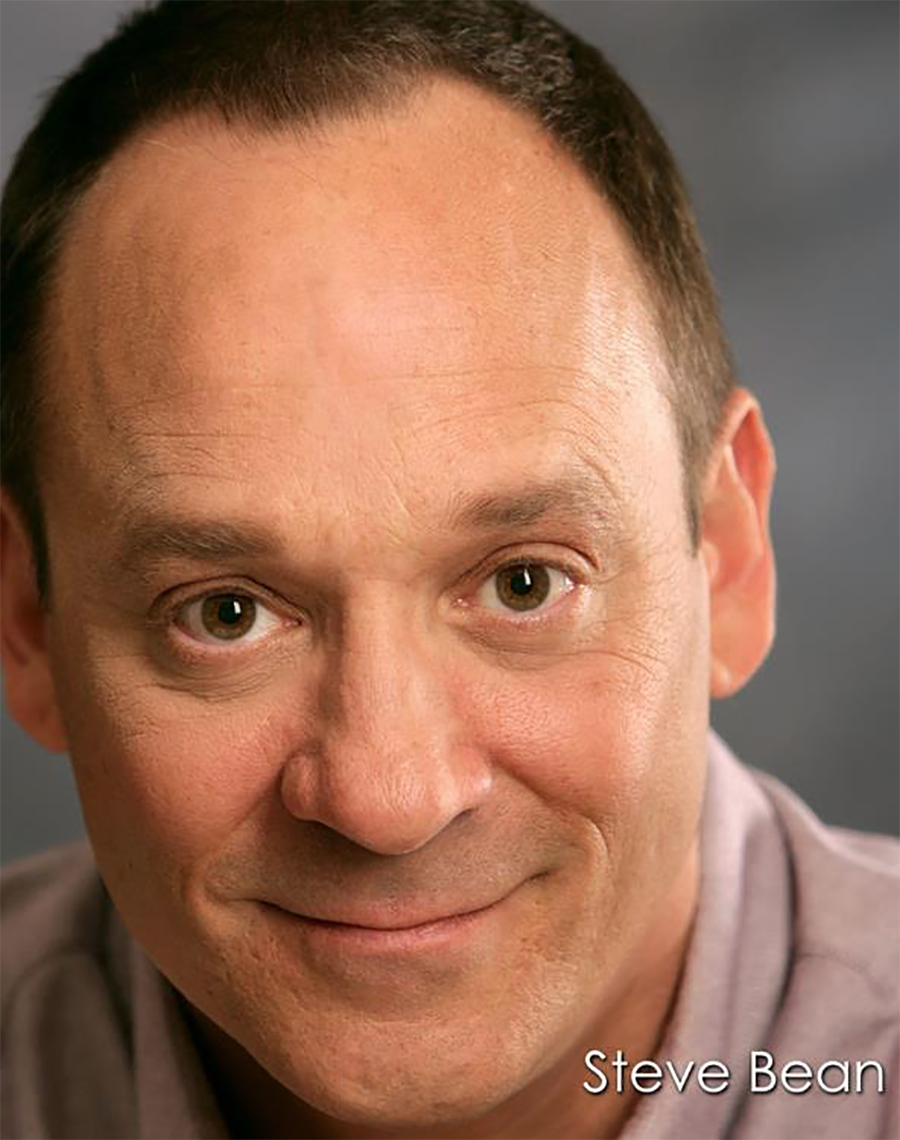
Just before Christmas, I went to an ear, nose and throat specialist in Tarzana. He concluded that I had chronic sinusitis, polyps and a deviated septum, and informed me, rather boastfully, that a simple outpatient procedure would return me to normal. Almost. By now, my nose had swollen considerably; I looked like a retired boxer. I explained to Dr. Tarzana (not his real name) that I was an actor. I needed my nose to look like my nose. “No,” he said flatly, “Your nose will remain misshapen.” It was clear that he couldn’t have cared less.
Dr. Tarzana continued to brag about the “miraculous” miniature robotic cameras he’d be using during my procedure. During our first visit, I felt some blood trickling down the back of my throat, so instinctively, I coughed. “Don’t cough,” I heard Dr. Tarzana say. “There’s no reason to cough.” Is he kidding me? Some blood dripped out of my nose and onto his floor. I was visibly upset. Nervously, I grabbed a tissue and stooped down to wipe up the blood.
“I think you’re overreacting a little bit here, bud,” Dr. Tarzana responded.
A couple of Thursdays later, I was in-and-out of the Tarzana facility in no time flat. Dr. Tarzana informed my wife Caroline that in addition to curing the sinusitis, polyps and deviated septum, he also performed a biopsy. We’d have a follow-up with him in a week or so to confirm that all was well.
About 72 hours later, though, we got a call from his office: Could we come in today? Today.
That was when I first said to myself, “Oh, shit.” We were prepared for the worst, and that’s what we got. “I don’t have good news for you,” offered Dr. Tarzana, his voice devoid of emotion. “This is cancer.”
Two days later, we met with Dr. Keith Blackwell at UCLA Health. He smiled kindly, and explained that I had a rare and aggressive form of cancer called Sino-Nasal Squamous Cell Carcinoma. In English, I translated that to “Nose Cancer.” I inquired as to how one might contract such a disease. His answer: “The only things known to actually cause Squamous Cell Carcinoma are… well, have you ever worked in a nickel mine?” No. “Or done a lot of carpentry?” No. The third possible cause, he said, was Bad Luck.
We were now joined by a team of a half-dozen or so other doctors and residents. Every last one of them was smiling. “Why,” I asked myself, given the seriousness of the diagnosis, “are they all smiling?” I soon realized it was because they’d unanimously agreed upon a completely plausible way to save my life — they were going to cut off my nose!
Blackwell told us this with such nonchalance, for a moment, I was able to believe that I was still on this planet. They were going to cut off my nose, then go inside my sinus cavity and remove the tumor. Surgery would be followed by several weeks of recovery, then 35 radiation treatments (five times a week, for seven weeks) interspersed with six chemotherapy treatments. In approximately a year, I’d have a lovely new prosthetic nose made of silicone, thanks to the maxillofacial prosthodontists at the UCLA School of Dentistry.
On March 2, 2017, Blackwell and his team performed a schnozophomy. That’s Yiddish for rhinectomy, which is English for cutting your nose off. I was in surgery for 12 hours, from 7:30 a.m. to 7:30 p.m. They removed my nose, my tumor, my upper gums, all of my upper teeth and two-thirds of my upper palate. Soon thereafter, in preparation for radiation treatments, the majority of my bottom teeth were also removed. I was left with a total of four teeth, all on the bottom.
But for the moment, I want to tell you about the hole in my face. I want to tell you about The Wound. When I first saw it, I felt like Eric Roberts in The Pope of Greenwich Village: “Paulie! They took my noooose!” Then I was George Bailey in It’s A Wonderful Life, as Clarence the Angel tells me, “You’ve been given a great gift — the chance to see the inside of your own head.”
And I can really look IN there. There’s a vast space here. This was my sinus cavity! This is the interior of my skull! To examine The Wound for the first time, I began by removing my plastic nose. It’s more of a nose-shell, really, with a nose-shape in the center, partial plastic cheeks and a bit of upper lip. Beneath the shell, I was delighted to find that Dr. Blackwell had built a very realistic nose out of gauze! It was a little crude, but quite nose-like, really very well done. He had built it skillfully, and I imagined, quickly and expertly, the way a seasoned balloon-artist might make a balloon animal, finishing off with a flourish, saying, “There ya go, little fella, it’s a nose!”
As I disassembled the gauze-nose, I was again impressed, this time by the sheer quantity of gauze that Blackwell used; there was enough for five noses. I became a vaudeville magician, “The Wizard of Gauze,” performing my take on the Endless Handkerchief Trick. The more gauze I unraveled, the more there was to unravel
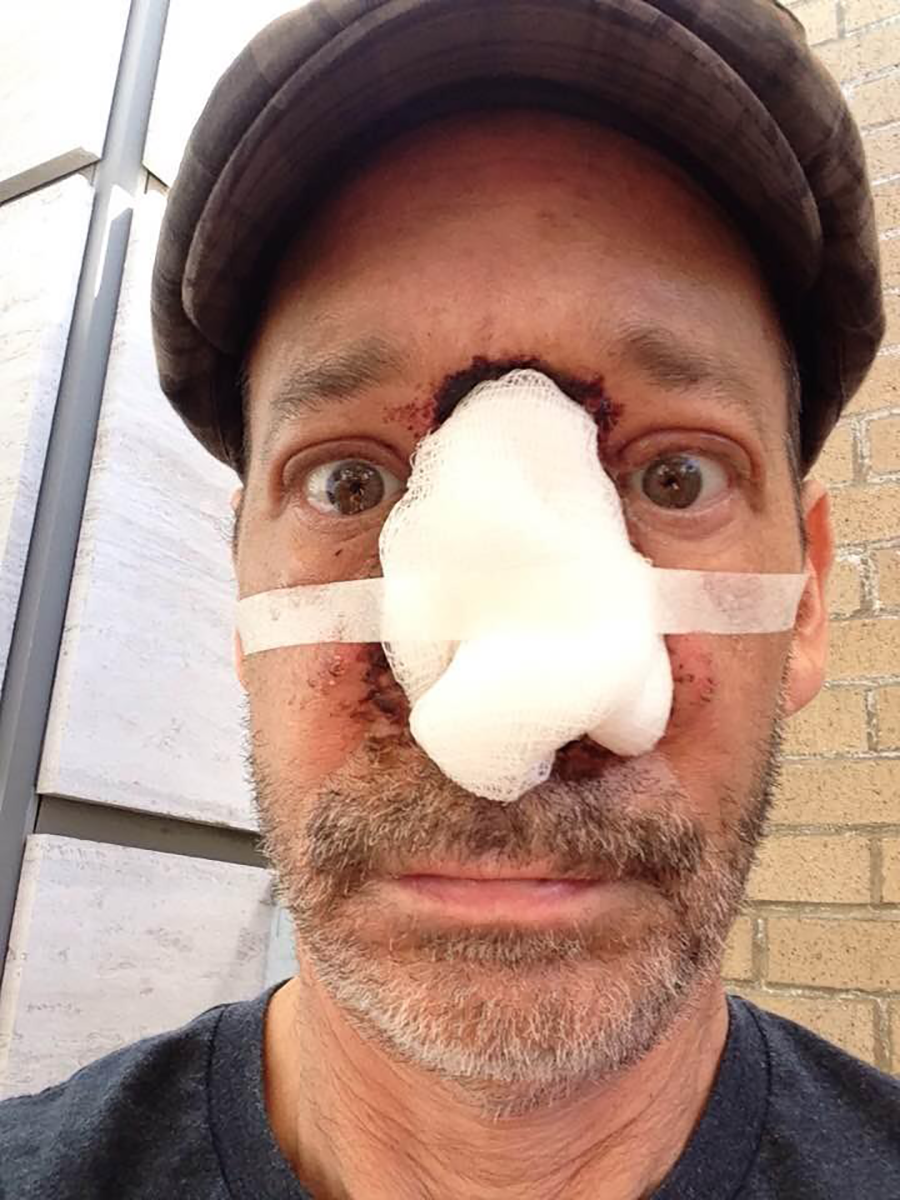
The gauze was stained with all manner of grossness. Here was dried blood, pus, mucus, various and sundry bodily fluids. Some of it was scabrous, in colors gold, yellow, orange, red, brown and still other new species of color, yet to be named or catalogued. The very end of the endless gauze-roll had scabbed over; it was stuck in a few stubborn spots to the interior of my cranium. Caroline sprayed it down with saline solution, to dampen it, to loosen it. A few last pulls of the salt-dampened gauze, and we were left with only The Wound itself.
It looked like someone had shot me in the face. But they’d somehow done so with near-geometric precision. Here was a pseudo-triangular nose-shaped “hole” in my face, dead center, with the three points of the triangle slightly rounded. I wondered, How did Blackwell manage to do this without damaging my eyesight? A few weeks later, we had a follow-up with Dr. Lee, one of the other surgeons, and she said, quite matter-of-factly, “I’m glad we were able to save your eyes.” It never occurred to me that this deal might rob me of my vision, too.
Even today, inside The Wound is an entire world — a vast cave, a chasm. There’s a complete alien landscape in there, on a planet never before explored. How can there be so many shades of pink, so very many shades of what Crayola used to call “flesh-colored,” such a rancid rainbow of maroon, green-yellow, black and even white? So many types of tissue and terrain! I half expect to see tiny sparkling shards of crystal embedded in the walls. There ought to be tiny miners in there, suspended from ropes, holding miniature searchlights and pickaxes. The whole thing is indescribably disgusting. It’s A Horror, and I cannot turn away from it. It’s also a secret — no one is meant to see it.
I’m compelled to continue to find ways to describe it, as if to describe it might somehow be to make sense of it: Inside my head, there’s an ancient, lost, underground world.
Standing on the cave floor, when you look up, you can see flesh stalactites. The Wound, to this day, continues to be a source of fascination and disgust. There’s always a fatal car crash going on inside of my face, and I can look at it anytime. Often, I just can’t look away. On a positive note, having no roof-of-mouth and a hole for a nose does create exciting new possibilities for finger puppetry.
After surgery, there was a prolonged period of rest and recovery, followed by a prolonged period of radiation and chemotherapy, severe fatigue and major depression. I set impressive new personal bests for sleep-duration, often staying in bed for 18 hours at a time. Eventually I realized that the fatigue fed on fear. It wasn’t just that I was too weary to get out of bed — I was too scared. In bed, I was safe. Under the covers, cancer couldn’t get me. But out of bed — out in The World — anything could happen; there was great danger. It took about 12 weeks (one week of recovery for every hour of surgery) for me to regain any measure of strength. Then, I began radiation.
Getting a radiation treatment was like going into a time machine that took 20 minutes to send you 20 minutes into the future. I laid down on a slab; the slab slowly slid me into a giant electric donut that appeared to have been borrowed from the 2001: A Space Odyssey prop department. I emerged 20 minutes later with a throat more dry than a lint screen in a Mojave laundromat. Nonetheless, a simple routine was established: Stay in bed for as long as possible; get up, drive an hour (at least) in traffic to UCLA, get radiated, drive back home for another hour (at least); get back in bed; stay in bed. (In bed, I was safe. In bed, they couldn’t radiate me.) Then rise, ride, radiate, ride, rest and repeat.
Radiation caused a permanent decrease in saliva production. My salivary glands would never again produce the quantity of spit that I’d come to take for granted. This was a common side-effect called “Dry Mouth and Throat.” But for countless nights, to say that I had a “dry” mouth and throat doesn’t begin to describe the impossibly uncomfortable levels of dryness I experienced. While I slept — or tried to sleep — everything from my eyeballs to my Adam’s apple seemed to fuse together, until the entire affected area felt like the interior of a cinder block that had sat in the sun for countless hot and dusty summers. There was no way to tell where my tongue ended and my throat began; it was all one brick, made from the driest of clays, baked overnight-after-night in the most parched and barren kiln.
The tongue couldn’t be moved. The lips neither. They’d also melded together. The throat couldn’t be cleared. It had Dried Solid. The struggle expanded from physical to mental: Part of my brain wanted to wake up and do something about this; part of my brain wanted to sleep. But I wasn’t really sleeping anyway, I was fighting: “Can I please, please either fall into a deep enough sleep where this won’t trouble me, or can I please pull myself awake to take a drink of water?” This restless struggle continued through countless nights that lasted for days. And on those nights when it was at its worst, to take a drink of water was actually quite painful, because the act of swallowing had become, in itself, extremely difficult.
Radiation also aggravated a side-effect of the surgery known as “dry, watery eyes.” How is it possible to have eyes that are both dry and watery? “You have no tear ducts,” Dr. Blackwell explained, cheerfully. They were in the way. They had to be sacrificed to get to the tumor. So my tears have nowhere to go. This hasn’t changed either. They’re still produced, but their drainage system is gone. By day, my eyes are chronically wet. Tears roll aimlessly down my face, sometimes often, sometimes intermittently. By night, though, my eyes are chronically dry. The tears have nowhere to go. They sit there. They gather there — they dry there. My eyes dry over. They dry shut. They close, and they won’t open. Some mornings a crust has formed along the edges of my eyelids, through my eyelashes, locking the lids closed. Most mornings I have to manually pull my eyelids open.
Sometimes during the day my eyes will stop tearing for a while, and I’ll forget all about it. Then, as if from nowhere, a teardrop will suddenly fall onto the words I’m typing, into the soup I’m making or onto the steps I’m taking. Sometimes, I’ll look in the mirror and (this is surreal) see a real teardrop sitting on my plastic cheek. So the tears are rolling all day, often while I’m not even aware of it. It’s as if my body, independent of me or my thoughts, is mourning the loss of the nose; the body is crying because it’s missing one of its own. Or, is it possible that my body is trying to fill the hole in my face, albeit with tearfall?
During the seven weeks of radiation, I had chemotherapy once a week. My chemo was administered intravenously; a session took about three hours. Chemo is poison; the purpose of the poison is to kill the cancer cells. But the poison also compromises your entire immune system. By the time my chemo treatments came to an end, I was back in the hospital with pneumonia. Fatigue had become overwhelming — before it was merely “whelming.”
And while the chemo may or may not have killed my cancer, it certainly killed my appetite. My taste buds were fried away. New baby buds grew in their place, but these new buds didn’t know how to taste yet, so everything tasted different than before. I didn’t know what was worse, the fact that nothing tasted good, or the fact that everything tasted bad. The thought of ingesting anything became repugnant. Caroline went to great pains to concoct delicious, nutritious smoothies for me, but all I could do was stare at them and try not to cry. Night after night I sat up in bed, staring at the latest smoothie, and fighting the sobs. What finally helped was this: I had two close friends who had died of cancer, Roger and Robert. I would call upon their strength: “Roger, Robert, please help me put this smoothie to my mouth. Please help me drink this smoothie.” And they always did.
Another side-effect of chemotherapy was what the medical community calls “Chemo-Brain.” It’s like dementia. Caroline and I went to a head and neck cancer support group at the University of Southern California once, and there was a very colorful fellow from New York who had suffered from Chemo-Brain. He said, “Repeatedly I found myself going to Costco and returning home with gallon jugs of ketchup, with the intention of using it as a condiment to enjoy with my scrambled eggs. Then I’d suddenly remember that I don’t like scrambled eggs. In fact, I hate them, and I never eat them.” Luckily, I never suffered from Chemo-Brain as severely as this New Yorker. For me, what happened was I forgot — or would forget — the word “tumor.” I would tell people about what had happened to me, and when I got to the part of the story where Dr. Blackwell removed my nose in order to remove my (tumor), the word just wouldn’t be there! This still happens. It’s as if when Blackwell removed the physical tumor from my sinus cavity, he also removed the word “tumor” from my brain.
Today, I’m like Eleanor Rigby — I wear a face that I keep in a jar by the door. Actually, I keep mine in a pile in a drawer, but McCartney has written the superior lyric. We’ve all heard a woman say, most likely in an old-timey TCM movie, “I have to go back inside to put my face on.” I can’t count the number of times I’ve walked out the front door without my nose and had to turn back and go inside to “put my face on.” Nor can I count the number of times we’ve been about to head out, and I’ve had to say to Caroline, “Honey, have you seen my nose anywhere?”
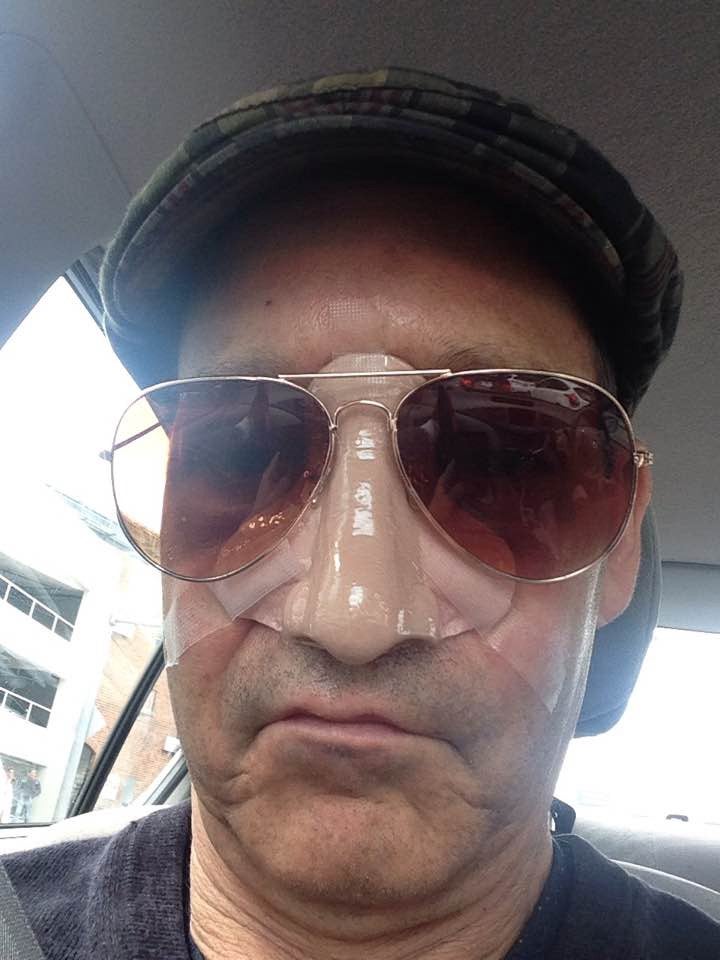
Facial installation is a bit of a process: The first piece of face is the “lower partial,” a bridge/denture with 11 false teeth, that fits snugly onto my four existing teeth. And when I say “snugly,” I mean “too fucking tight.” It feels like someone has taken a screwdriver and screwed every one of my bottom teeth in an extra couple of turns.
Then comes the obdurator, which serves not only as my top gums-and-teeth, but also as my upper palate and part of my right cheekbone. I’m still impressed that such a large piece of hardware can fit inside my head. Wearing the obturator feels like holding a hockey puck in your mouth, or like some kid made an ashtray at summer camp, then jammed that ashtray into the roof of your mouth. I also should add that without the obdurator in place, I cannot utter a single understandable word. Take it out, and you take away my ability to speak.
Eating with the obdurator and lower-partial in place (and they must be in place for me to eat) is like trying to eat with somebody else’s teeth. And because I don’t have a natural upper palate, some of everything I eat comes out of the hole in my face and dribbles onto my face or floor. Additionally, my radiation caused severe tightening of the jaw. Thus, I cannot open my mouth wide enough to accommodate even an Oreo.
Next, I take a 4-inch by 4-inch piece of gauze, fold it once down the middle, then continue as if making a paper airplane. When the gauze has reached peak triangle, I insert it into The Wound, balancing it in the very center, at flesh-face level. I then take my nose, put one piece of medical tape at the top, one on each corner, position it and fasten it carefully, and I’m on my way — a flesh man with a plastic face.
Caroline had provided the maxillofacial prosthodontists at The UCLA School of Dentistry with 175 photographs of me and my nose, on which they could base their work. But I wanted to be absolutely certain that they had the one picture that I felt really mattered, so I brought in my favorite photo of me, my father and my son Jake together. We three look remarkably alike — it’s the same nose on each face. I told the prosthodontists, “Here’s the same nose at three different stages of life; this should give you everything you need to design a real beauty.”
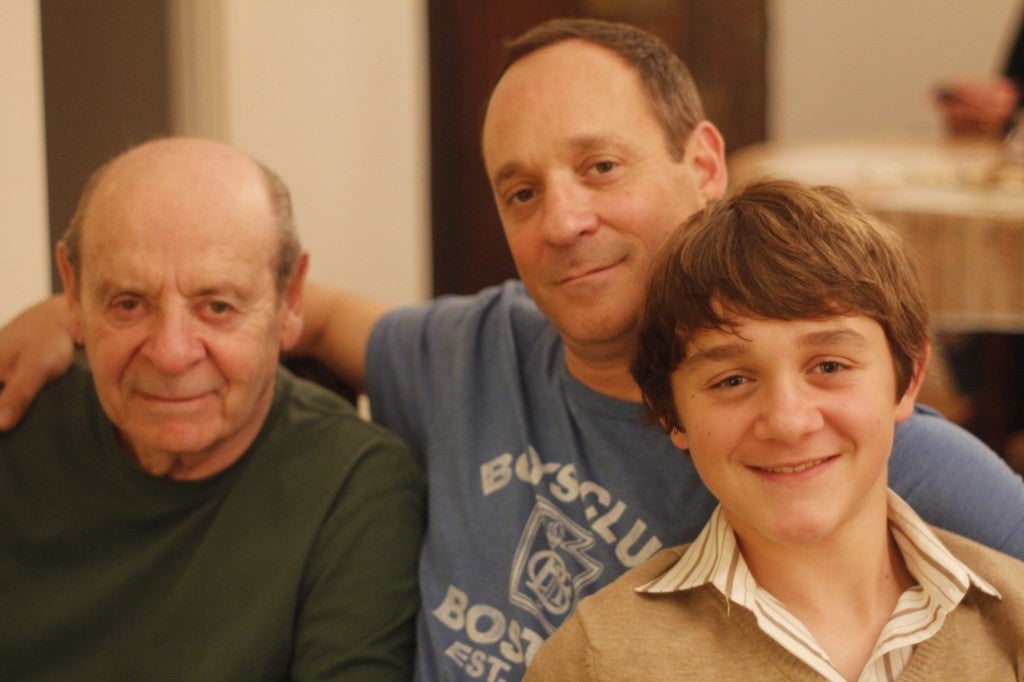
Dr. Jayanetti, the head prostho-honcho, had a brilliant idea: “Is Jake going to be home for winter break?” he asked. “Yes,” I replied. Jayanetti continued, “Why don’t you bring him in with you next week? We’ll take a mold of his nose, then make your prosthetic directly from that mold.” It was an ingenious solution! It would be as close as they could possibly get to giving me my very own nose back. And I’d be able to look in the mirror, see my son’s nose on my face and say, unequivocally, “I love it! I love my face. I love what I see.” Here was an honest-to-God “Christmas miracle!”
All this excitement coincided with my latest scans. I’d just had a routine CT scan and pet-scan. I’d have them every three months for the first two years after surgery, then every six months for two years and then once a year for the rest of my life. A few days before the long-awaited “installment” of the nasal prosthesis, the scan results came back: There was a recurrence of the cancer. In the cheek just below my right eye. No new nose for now.
There was another surgery. Blackwell removed the tumor, my right cheekbone, the rest of my upper-palate and most of my right jawbone. The hole in my face is bigger now. There are more radiation treatments. Later, when my recovery from this second surgery is well underway, a nurse removes 72 staples from my head.
If you’re keeping track at home, I’ve now lost my nose, my tear ducts, my upper palate and gums, all but four of my teeth, my appetite, my right cheekbone, much of my right jawbone, much of my right cheek, my eyebrows and moustache (chemo), the feeling in my upper lip (surgery), most of the motor control of the right side of my face (surgery) and some hearing in each ear (chemo). I also lost about 40 pounds, and worst of all, I lost my sense of humor.
All of that physical stuff ain’t ever coming back. Luckily, my sense of humor came back about a month ago. Not a moment too soon either: The latest scans show yet another recurrence of the cancer. The doctors tell me I have nine to twelve months to live.
